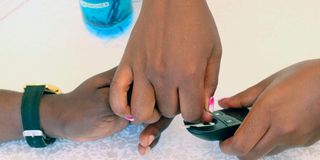Study: Six in 10 Africans living with diabetes unaware of their condition

A patient gets tested for diabetes at Jaramogi Oginga Odinga Sports Complex in Kisumu on September 9, 2023.
About six in 10 Africans living with diabetes are unaware of their condition, despite the disease being easily diagnosed through routine screening and blood tests.
A new report—Global Industry Diabetes Overview 2023—published by the Aging Analytics Agency, shows that undiagnosed cases on the African continent are far higher than the global rate of 40 per cent.
Africa leads in the number of undiagnosed cases, followed closely by South East Asia and the Western Pacific regions.
Diabetes is a chronic condition that occurs when blood glucose levels are elevated because the body is unable to produce any or enough of the hormone insulin, or cannot use the insulin it produces effectively.
The report also shows that Africa has the lowest number of known people living with diabetes at about 24 million. More than 500 million people worldwide are living with the condition.
The Kenya Demographic Health Survey 2022 shows that only 1 per cent of men and women aged 15-59 have been diagnosed with diabetes. Of these, more men (73 per cent) than women (63 per cent) are taking medication.
Global numbers are likely to rise by 2045, when the survey estimates that nearly 800 million people will be diagnosed with the disease.
South-East Asia and the Western Pacific have the highest number of people living with diabetes —around 90 million people each.
The report states that the rise in new cases could be due to changes in food consumption and nutrients intake over the past four decades, as incomes have risen and urbanisation has increased.
“Although dietary patterns may differ minimally between different parts of our planet, they tend to have many characteristics in common,” the report states.
It adds: “Traditional diets high in fibre and low in fat have recently been replaced by a type of ‘Western diet’ that is high in fat, saturated fat, sodium, cholesterol, free sugars and added sugars. There has been an increase in snacking on junk food, especially among school children.”
In 2021, the report notes that there were about seven million deaths worldwide as a result of diabetes “despite the fact that more than $970 billion is spent on diabetes care” .
Countries outside Africa have the most resources for diabetes-related research and development, with the leading region —North America and the Caribbean—having about 200 times the resources Africa has. According to the report, Africa has only about five research and development centres working on diabetes drugs. The largest single country centre for diabetes research is the United States of America.
The report further indicates that more scientists took up research into the disease during and after the pandemic, but the number of scientific publications fell slightly last year compared to 2021.
The modern pharmaceutical market for diabetes, the report shows, consists mainly of three main sub-sectors: therapeutics (38.7 per cent), drug delivery (32.3 per cent) and devices (24.7 per cent).
“Since 2010, the number of antidiabetic regenerative medicines has increased due to the approval of cell therapies for wound healing, including cell therapy and gene therapy; however, the regenerative medicine subsector still holds only a 4.3 per cent share of the market,” the report states.
About 10 per cent of ongoing clinical trials involve non-insulin options for the treatment of diabetes, but human insulin remains the most commonly used drug for patients.
The report shows that the disease leads to other complications that do not require insulin to treat, such as heart disease.
“Cardiovascular disease is the most common complication of diabetes, so more than half of the non-insulin drugs are used to reduce the risk of heart failure, acute myocardial infarction and stroke,” it states.





